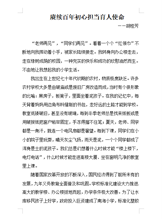托福综合口语TASK3两大类答题模板及使用技巧介绍
托福综合口语TASK3作为一道要求大家对学术性内容进行整理总结并进行叙述的口语题,其难度是比较高的。今天小编给大家带来了 托福综合口语TASK3两大类答题模板及使用技巧介绍,希望能够帮助到大家,下面小编就和大家分享,来欣赏一下吧。
托福综合口语TASK3两大类答题模板及使用技巧介绍
第一类: 关于某理论及支持范例 (theory and its examples, study, or research)
模版一:
In the lecture, the professor mainly talked about the concept / theory/ definition that ____.
To reinforce the theory, the professor gave two examples / reasons in his speech. In the first example, ____. The same thing happens ____.
模板二:
From the reading material, we know that…(关键术语,定义)
To demonstrate it, the speaker provides two examples/reasons/researches. One example is that……
Another example is that……。.So the suggestion is that……
第二类: 有关某问题/过程/特征的分析或研究 (regarding the analysis or research of certain phenomenon / problem / process /feature)
The reading passage describes the phenomenon / the problem / process / some functions /features of ____.
X.X.X ____ is ____(definition)
In the listening passage, the professor gives the demonstration of it by introducing some researches / analysis.
The first one is ____.
The second one is ____.
托福综合口语TASK3模板使用技巧讲解
在使用这些模板的时候,我们没有必要一味的照抄照搬,可以在大家掌握一些指示词和过渡词的情况下,实现同义替换,让这些模板更加有自己的特点。
(1)表选择关系或对等关系的连接词:either…or…,neither…nor, or, as well as…, and, both…and…。
(2)表因果关系或对等关系的连接词:therefore, so, as a result, as the result of …,because of, due to …,owing to, thanks to等。
(3)表时间顺序的连接词:the moment, as soon as, at first, then, later, meanwhile, at the beginning, in the end, before long, for the first(second…)time, the minute等。
(4)表转折关系的连接词:yet, and yet, but , while, on the contrary, on the other hand, however, at the same time(然而)等。
(5)表解释说明的连接词:that is, that is to say, in other words, such as, for instance, and so on, etc. and the like等。
(6)表递进关系的连接词:not only…but (also), what,s more, what's worse, besides, in addition, worse still, moreover, above all等。
托福口语拓展:Adam’s Apple
Adam‘s Apple喉结
亚当是圣经中人类的始祖,而苹果的历史比人类的历史还悠久。在世界各文明古国的民间故事和神话传说中,苹果都是受人喜爱的一种果实。英语中有个谚语:An apple a day keeps the doctor away.但据圣经故事上说,苹果也给人类带来了麻烦,男人的喉结就是因吃苹果引起的。《旧约.创世纪》第3章讲到人类的起源,传说上帝创造人类的始祖亚当和夏娃,在东方的伊甸(Eden)建立了一个园子给他们居住。伊甸园里生长着悦人眼目的各种树木,树上长着各种各样的果实。上帝吩咐亚当说:你可以随意吃园中的各种果子,只是不能吃那棵分别善恶树上的果实,吃了必定要死。这种“禁果”就是apple。后来,亚当的配偶夏娃听信蛇的诱惑,不顾神谕,吃了善恶树上的禁果,还把这果子给它丈夫吃。亚当因心怀恐惧,吃时仓促,有一片果肉哽在吼中,不上不下,留下个结块,就叫“亚当的苹果”两人吃了这果子就心明眼亮,能知善恶美丑。但是由于他们违背了上帝的告戒而被逐出伊甸园。从此,亚当就永远在脖子前端留下“喉结”,作为偷吃禁果的“罪证”。上帝还惩罚亚当,“必汗流满面才能糊口”
不过也说一说是正当亚当吃的时候,上帝来了,所以亚当急忙吞下去,不料哽在喉咙间了。
eg:Your Adam‘s apple isn‘t apparent.
Adam‘s apple can be more clearly seen on men than women‘s throats.
托福口语拓展:Bone of The Bone and Flesh of
Bone of The Bone and Flesh of the Flesh
Bone of The Bone and Flesh of the Flesh直译"骨中之骨,肉中之肉",出自圣经中关于上帝造人的神话.
据旧约创世纪第2章叙述:太初之际,混沌未开,耶和华上帝开天辟地.第一天耶和华创造了白天和夜晚;第二天创造了天空和风云;第三天创造了高山峻岭.平原河流,以及富饶的土地和芳香的花果;第四天他又创造了太阳.月亮和星辰,确定年岁.季节.月份和日期;第五天他创造了各种形状和大小的鱼类和飞禽;第六天他才创造了各种陆上动物,然后他按照自己的形象用地上的尘土造出一个男人,名叫亚当(Adam),这就是神话中人类的始祖.后来,耶和华见押当独居无伴侣帮助他,于是,趁亚当沉睡的时候,从他身上取下一根肋骨造成了一个女人叫夏娃(Eve),领到他面前,亚当说:"This is bone of my bone and flesh of my flesh"(这是我骨中之骨,肉中之肉)。从此两人结为夫妻。
Bone of The Bone and Flesh of the Flesh常用来比喻血缘上的亲属关系或思想上的团结一致,即as close as flesh and blood;to be inseperately linked to each other等的意思。
托福口语:Purpose of festivals
Q: Why do you think festivals are important events in the working year?
Answer:Yeah. It’s very important for two reasons.For the country, it’s a time to remember our cultural origin and our historical past.The whole country celebrates our root and it’s very inspiring.We become so proud of our past.I guess that’s why festivals are important.For the individual, festivals give us a chance for relaxation as we often have a few days off. It’s a time of fun, meeting friends, entertainment.So after that we feel like a new man.In a sense, holidays restore our balance between work and leisure.That’s also why we need festivals for China.
Q: Would you agree that the original significance of festival is often lost today?
构思:节日的初衷: 庆祝传统, 承上启下, 结束也是开始现在的节日: 人们繁忙, 感觉不到开始和结束的意义, 过完节,马上就再次投入到工作中, 有些单位甚至连节假日都加班. 人们也不在那么感动传统,倒是好好的利用节日放松了一下, 吃吃喝喝,购物,节日从tradition象 consumption过渡.更像是给了人们一个借口: 1. 放下工作 2. 奢侈享受 3. 见见好久不见的重要的人.这么讲的话, 节日也挺好的.
Answer:I think the original significance for festivals are to celebrate our tradition.It’s an end to the old year and the beginning of a new year. So it’s a connecting day.But today, people are so busy, they’re under so much pressure and they no longer feel the transition between the old and the new year. Some companies even ask their employees to come in on holidays. So many people begin to feel that festivals are just as common as the other days.People no longer take the opportunities of festivals to honor their tradition,but go shopping, go to restaurant to entertain instead.So I think tradition is out, consumption is in.Festivals provide people such an excuse to put down their work, to spend money and be extravagant (奢侈的), and to meet people that they don’t have time for during the working year.So in this sense, even the original significance is lost, festivals are still exciting.
Q: Do you think that new festivals will be introduced in the future? What kind?
构思:世界变化快, 人们拥抱新生活, 世界西方东方交融,西方人开始吃饺子, 过春节; 东方人开始互相送巧克力和玫瑰花, 过情人节.人们开始尝试新东西,可能将来也会考虑新节日.这样精彩的节日不再是national, 而是international,这样不是很酷吗?听说,有些人今年开始过 男人节 8.3, 很有趣, 有点傻,但是不得不说也是一个新鲜 的尝试.
Answer:The world is changing so fast.People are embracing new lifestyles as East and West come together.Westerners begin to eat dumplings with chopsticks to celebrate Chinese Spring Festival. And Chinese young people exchange chocolates and roses on Valentine’s day. So, you see? People are experimenting with new life patterns.And it’s quite possible that new festivals may be invented or introduced.Wouldn’t that be cool?What kind? Well, I don’t know for sure because it’s the future right?But I heard this year, in my country, some people celebrated the men’s day, which is on August the third.It’s dorky. (书呆子) But it’s new and exciting, right.Will it last? I don’t know.All I know is that this is an interesting attempt.
托福口语复述方法
1.间接转述(Indirect Speech)
口语复述的实质是将听到的和看到的话语用自己的话以口头方式再转达出来。“直接引述”是直接引用说话人的原话,而要用自己的话把别人的意思转述出来就称为“间接转述”。托福口语考试中一般应采用“间接转述”的方法:针对特定问题,用自己的话把读到、听到的对话内容或演讲内容再重复出来。对考生来说,这当然是一个更高层次的要求。因为,首先要听得懂、读得懂别人的观点,其次才能在此基础上进行加工处理,变为自己的语言再陈述出准确意思来。这时候,“善于把别人的东西据为己有”就不再是一个“恶劣的行径”了。此时此刻,它将转化为一个极为有效的、甚至是高效的手段,以此来达到“借鸡下蛋”的目的。
请看下面几例:
例1:My mother said: “I’m so tired that I don’t want to cook. Shall we eat out tonight?”
➔ My mother said that she was so tired that she didn’t want to cook and she suggested that we should eat out that day.
例2:Tom said: “I’ve already seen the film.”
➔ Tom said that he had already seen the film.
间接转述应注意以下几点规则:
⑴ 在转述的引语前一般要用连词that:(如例1、例2所示);
⑵ 要根据意思改变人称(如例4所示);
⑶ 当要转述的言语为连贯的话语时,应用go on(继续),continue(接着),add(补充)等,以及各种引述动词,如:note(指明),remark(谈及)
⑷ 间接转述不是重复原话,因此,时态要有所变动。一般来讲,现在时变为过去时,过去时变为过去完成时。指示代词、地点及时间状语也要作必要改动。释义、意译(Paraphrasing)
Paraphrase (to express in a shorter or clearer way what someone has written or said) 就是用你所知道的,或者对你来说较容易的词汇、短语、以及语法去解释那些较为难懂的语句。概述(Summarizing)
Summarize (to make a short statement giving only the main information and not the details of a plan, event, report, etc.) 就是用简练话语概括描述一篇材料的中心思想。
新托福口语考试的听、读材料都不长,三言两语即可概括全文的中心意思,没必要长篇大论。当然,时间也不允许这样做。所以,高度概括的口语表达能力是顺利通过托福口语考试的法宝之一。


